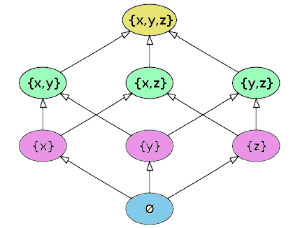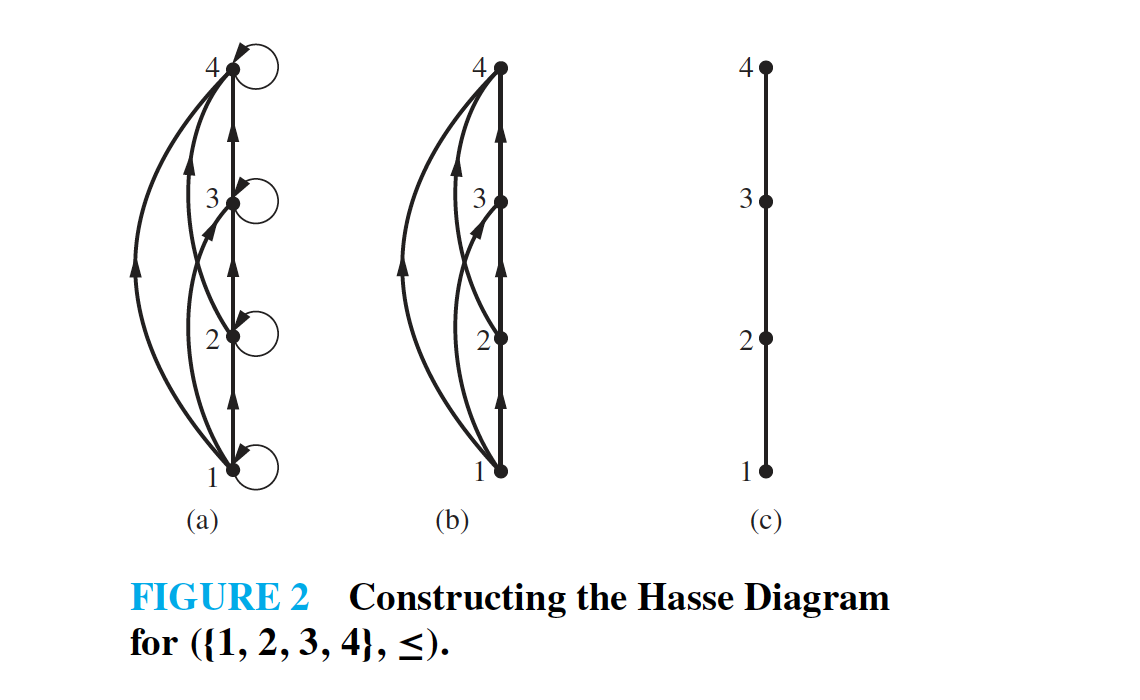

In Mathematics, A relation between elements of two sets can occur in many contexts. Like consider a relation between two sets of stations linked through trains.
A relation set between two relations say A and B is a subset of cartesian products of A and B
Ordered Pairs can be used to express relation between two elements. These are called as binary relations.
A binary relation from A to B is a subset of A x B;
Example Let A = {0,1,2} and B = {1,2} then a relation set of {x | x ∈ R x =x} is given by {1,1} ,{2,2}
A relation between a function from A to B is defined by assigning exactly one element of B to A;
The graph of f is the set of ordered pairs (a, b) such that b = f (a).
Example A relation on a set A is a subset of A x A. Because A x A has n2 elements
when A has n elements, and there are 2 n2 subsets of A x A. Thus, there are 2 n2 relations on a set with n elements.
A relation on a set A is a relation from A to A.
A relation R on a set A is called reflexive if ((a, a) ∈ R) for every element a ∈ A.
A relation R on a set A is called symmetric if (b, a) ∈ R whenever (a, b) ∈ R , for all
a, b ∈ A. A relation R on a set A such that for all a, b ∈ A, if (a, b) ∈ R and (b, a) ∈ R, then a = b is called antisymmetric.
A relation R on a set A is called transitive if whenever (a, b) ∈ R and (b, c) ∈ R, then (a, c) ∈ R, for all a , b , c ∈ A.
Let R be a relation from a set A to a set B and S a relation from B to a set C. The composite of R and S
is the relation consisting of ordered pairs (a, c), where a ∈ A, c ∈ C, and for which there exists an element b ∈ B
such that (a, b) ∈ R and (b, c) ∈ S. We denote the composite of R and S by S ◦R.
Relations can also be expresed using zero-one matrices and directed graphs. We are considering relations to be binary relations hereon.
using zero-one matrices.If two sets A and B are equal then the relation R between them is given by:
mij = 1 if (ai , bj) ∈ R and mij = 0 if (ai , bj) ∉ R
Relations can be expressed using Directed graphs (Digraphs), in this elements of sets are represented by a point,
and all the ordered pairs are represented using an edge with their direction shown using arrows.
A directed graph, consists of a set vertices and a set of ordered pairs of elements of vertices called edges.
The vertex from which the arc starts is called the initial vertex , and the vertex where the arc terminates is called the terminal vertex.

Example Draw a directed graph of the following ordered pairs: {(1, 1), (1, 3), (2, 1), (2, 3), (2, 4), (3, 1), (3, 2), (4, 1)}
Let R be relation containing ordered pairs (a, b)
which determine connection between two cities. If there is no direct connection between two cities,
then the ordered pair won't exist in the Relation set, even though there is a connection indirectly.
In such cases, we need to construct a transitive relation S which is a subset of R such that it contains all the transitive relations in R
This is called as transitive closure
Reflexive closure: A relation that contains reflexive pairs, for example, a relation set R of an ordered pair of (a, b) should contain (a, a ) and (b , b) ∈ R to form a reflexive closure
Definition 1: A path in a directed graph form (a ,b) is sequence of vertex from a to b where terminal vertex of an edge is the same as the initial vertex in the next edge in the path.
Theorem: Let R be a relation on a set A. There is a path of length n, where n is a positive integer, from a to b if and only if (a, b) ∈ R n.
Definition 1: A relation is called an equivalence relation if it is reflex, transitive and symmetric
Definition 2:Two elements that are related by an equivalence relation are called equivalent. ~ is used to denote that two elements are equivalent elements with respect to a particular equivalence relation.

Equivalence class of an equivalance relation partitions a set into disjoint, nonempty subsets.
A set with a binary relation R such that, for certain pairs of elements in the set, one of the elements precedes the other in the ordering that is partial order is created
least element is an element of S that is smaller than every other element of S
Example: The set Z, with the usual ≤ ordering, is not well-ordered because the set of negative integers, which is a subset of Z, has no least element.
This is the ordering which is based on ordering of letters in alphabet. The words in a dictionary are arranged in lexographic order
The lexographic order on two posets (A , ≤) and (B, ≤) is defined by specifiying that one pair is (a0, b0) is less than (a 1, b1), that is, (a1, b1) ≤ (a2, b2),either if a ≤ b or if both (a1 = b1) and a2 ≤ b2.
As we know from above discussions that Partial Ordering is reflexive, transitive. Hence in a directed graph for a poset, say {(a, b) | a ≤ b} on the set {1, 2, 3, 4} we don't have to show loops for all the vertices ( 1, 2, 3 and 4), as it is implicit.
Similarly, as the poset hold transitivity, if (1 < 2) and (2 < 3) this implies that (1 < 3) hence, we don't need to show a directed edge from 1 to 3.
If we assume that all edges are pointed upwards, we need not show the direction of vertices

An element in a poset is called maximal if there is no element in set greater than that element.
Similarly, an element is called minimal if there is no element lesser than that in a set
Hasse diagram can be easily used to find maximal and minimal elements as they are respectively top and bottom elements in the diagram
An element which is lesser than all other elements in the set.It is unique when it exist
An element greater than every element in the set and is unique when it exist
An element which is greater than or equal to all the elements in the subset is an upper bound
An element which is less than or equal to all the elements in the subset is a lower bound
An element x is called a least upper bound of a set A if it is lesser than all other upper bounds of A there is only one such element like this
An element which is greater than all the lower bounds of a set is a greatest lower bound. There is only one such element
A poset in which every pair of elements has both a least upper bound and a greatest lower bound is called a lattice.
The cases where certain task can be completed only after some other task are completed, partial ordering can be done. Topological sorting can be used to construct total ordering from partial ordering
LEMMA 1: Every finite nonempty poset (S, ≤) has at least one minimal element.